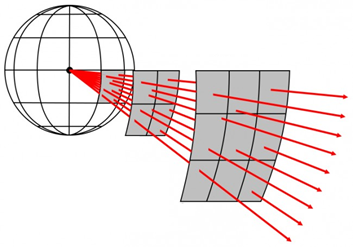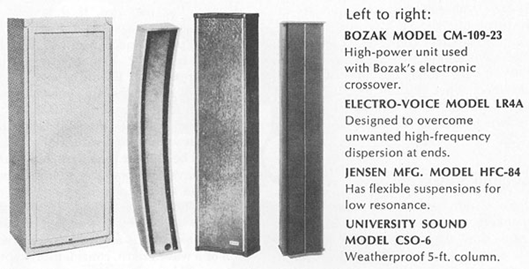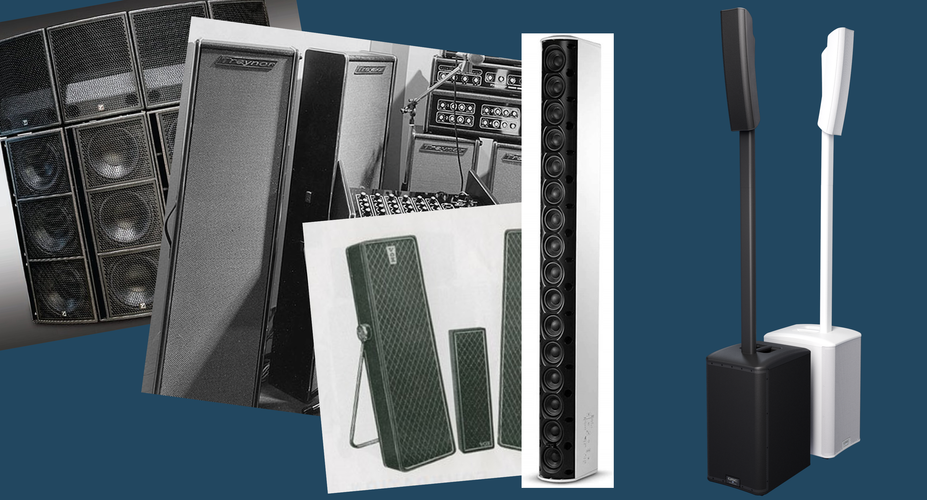In the field of electroacoustics and sound radiation, there are two fundamental types of sound sources that each provide specific radiation patterns and sound characteristics, both of which may be desirable depending on the application. These are the point source and the line source (or column source).
This article will review the basic acoustical principles behind these source-types, as well as delve into the history, development and use of column source loudspeakers, describing their strengths and weaknesses.
Point Source Loudspeakers
Most point source loudspeaker designs encompass multiple independent transducers adjacent to one another (a combination of tweeter and woofer, or tweeter, midrange, woofer). One exception is coaxial designs, which use a combination of tweeter and woofer built into the same transducer, with the tweeter superimposed within the center of the woofer assembly. These loudspeakers are designed to radiate sound from a (theoretically perfect) single point, generating so-called “spherical” wavefronts, which provide uniform dispersion in both vertical and horizontal directions. They are typically used in small-to-mid-sized venues where achieving coverage-control over very long distances is not required. In terms of sound propagation over distance – or the loss of level as sound propagates through air – point source loudspeakers generate spherial wavefronts, which follow the Inverse Square Law, where sound decreases by 1/d2 (d = distance in meters from the source). Therefore, for spherical wavefronts the sound level decreases by 6 dB every time the distance is doubled.

Line Array Source Loudspeakers
Line array loudspeaker systems comprise a series of identical loudspeakers each, once again, encompassing tweeter(s), midrange(s) and woofer(s), but this time arranged in a vertical line that is engineered to work together as an array to produce a single cohesive sound wave. This system configuration allows for a controlled dispersion of the radiated sound, which can be tailored to the acoustics of the venue, particularly in the vertical plane.
Referring again to sound propagation over distance, line array loudspeakers theoretically generate cylindrical waveforms, which maintain consistent sound pressure level over longer distances compared to the spherical wavefronts produced by point source loudspeakers. The radiated cylindrical wavefront provides less attenuation of sound over distance, and the formula for this decrease follows 1/r (r = distance in meters from the source), meaning that the sound level decreases by 3 dB every time the distance is doubled. It should be noted that this is only strictly true for “infinite” lines. As the length of the line increases, the line array will converge towards producing a sound-level decrease of 3 dB for every doubling of distance, but most practical “finite” line arrays will never achieve this. Furthermore, this effect is frequency-dependent, with higher frequency sound waves (correspond to shorter wavelengths) requiring shorter lines to achieve a 1/r propagation.

Column Source Loudspeakers
Column source loudspeakers, which also radiate cylindrical wavefronts (over a certain bandwidth), have been around for well over half a century, gaining popularity over the last 20 years. They often provide wide horizontal coverage, minimal vertical coverage above and below the enclosure and coherent sound in the vocal range, all being attractive features, particularly in highly reverberant environments. Most designs use a series of small drivers (typically 2 to 3 inches) mounted next to one another in a long column-shaped enclosure. Some designs use one, or more, tweeters (usually dome types). Conventional designs never include any low frequency drivers.
A Short History of the Development of Column Loudspeakers
Early sound reinforcement systems took advantage of the greatly improved efficiency of horn loudspeakers as soon as they were available. The directional characteristics of these horns, as well as their relatively high electrical-to-acoustical energy conversion, achieved practical results from the relatively low power of triode-output tube amplifiers. With the advent of more powerful power amplifiers, efforts began to explore new loudspeaker designs that could provide even greater directivity control. The idea of a line of drivers concentrating energy in the on-axis direction with in-phase energy addition, while reducing energy elsewhere, by using amplifiers powerful enough to adequately power all the direct radiating drivers in a column-shaped design, was a natural development.
Column loudspeaker development dates from the early 1950’s, and initial research began even earlier. They were used as PA systems – and mainly intended for the reproduction of speech – due to their ability to direct the sound over a wide horizontal angle and a very narrow vertical angle, instead of dispersing sound where it was not wanted or needed. This resulted in reducing reverberation and increasing speech intelligibility in large rooms and large acoustically untreated auditoriums. It also reduced the possibility of acoustic feedback to the microphones. Their response was not capable of covering the entire audible frequency range but was more than adequate for voice, and even music with band-limited content.

The use of column loudspeakers was first described in a 1952 paper discussing a pioneering installation in St. Paul’s Cathedral, London2, followed by the installation of an experimental system at Boston’s Holy Cross Cathedral3 in 1954. The first commercial applications in North America were pioneered by North American Philips, with cone drivers manufactured in Holland for a system installed at New York City’s Congregation Shaharith Israel4.

Designed for Specific Applications
As discussed previously, column source loudspeakers have been historically designed to be able to reproduce speech in very reverberant spaces like churches, large auditoriums and meeting rooms where communication is crucial. Such PA systems provide a wide and consistent horizontal coverage with minimized vertical coverage over a defined bandwidth – the human voice spectrum. This is an important point to highlight and the cause for confusion for many users in many applications.
Several aspects of the physical design of traditional column source loudspeakers reveal some of their limitations. First, the actual length (height) of the column determines the control of the directivity of the lowest frequencies, which means that the taller the column is, the better the control of the directivity will be at low-midrange frequencies. Second, the taller the column is, the narrower the control of the vertical directivity becomes. So, the more reverberant the space is, the taller the column source should be to minimize the excitation of the reverberant space (horizontally, the wide directivity is already exciting a significant portion of the reverberant space).
Next, regarding the size and driver arrangement within column loudspeakers, several issues arise when combining multiple transducers together that are all reproducing the same bandwidth. First, small drivers exhibit coupling behavior only up to a frequency whose wavelength is half the distance between adjacent drivers’ acoustic centers. Therefore, physical driver spacing determines the highest frequency at which a column of identical drivers acts as a column source. As an example, column loudspeakers with tightly spaced 6.5-inch drivers will couple up to about 1000 Hz, 4-inch drivers will couple up to about 1600 Hz and 2-inch drivers will couple up to 3300 Hz. Above these frequencies, uneven radiation lobes appear in the coverage (polar response), inducing irregular directivity and inconsistent sound coverage.
A second aspect to consider, based on the height of the column, is the lowest frequency at which a column of identical drivers still acts as a column source. If we assume a 1 m long column source using 3-inch midrange drivers, their coupling will only properly occur up to about 2500 Hz due to the in-between driver spacing. Additionally, this design will only behave as a proper line source (radiating cylindrical wavefront with 1/r sound propagation) beginning at 2700 Hz. The reason is that when the radiated wavelength matches the size of the column, the system still acts substantially like a point source. The radiation will only truly become cylindrical (column source-like) once the wavelengths emitted are small relative to the height of the column (2700 Hz, which is about 1/8 of the column 1 m height in our example).
Below 2700 Hz, such a column design will exhibit a sound propagation better than a point source (spherical), but worse than a line source (cylindrical). So, one of the problems with conventional column designs is that the frequency range in which one can truly take advantage of the cylindrical (1/r) radiation (in this case, 2700 Hz and up) is precisely the frequency range in which the small drivers no longer properly couple with one another due to the physical driver spacing.
Therefore, it becomes clear that using a series of small drivers (2 to 3 inches) in a column loudspeaker cannot provide accurate reproduction of mid and high frequencies with controlled directivity up to, say, 15 kHz.
At the same time, at low frequencies (below 200 Hz), conventional designs cannot generate adequate sound pressure, as the small drivers’ surface area and limited displacement are unable to create the wavelengths needed to reproduce bass content. All the above elements are, of course, negligible when using column loudspeakers for speech reproduction. However, these issues become much more substantial when columns are used to reproduce the complete audio bandwidth. This trend began more than a decade ago, as the slim and unobtrusive aesthetic of column loudspeakers appealed to a growing audience and to many different types of applications. Nevertheless, a lot of customers have been disappointed with the audio quality of such systems due to the acoustic drawbacks described above.
KC12 – The ‘Column’ Loudspeaker Redefined
The development of the QSC KC12 loudspeaker started with acknowledging customers’ appreciation for the aesthetic of column-type designs, with the aim to design a PA system that could handle the complete audio bandwidth, and that would solve, at the same time, the constraints and compromises found in conventional column loudspeakers.
First, the KC12 system consists of a ported subwoofer, housing a 12-inch driver extending down to 40 Hz. Next, the groundbreaking design of the mid/high enclosure features a 1-inch compression driver combined with the innovative QSC LEAF™ (Length-Equalized Acoustic Flare) waveguide (introduced in the L Class Line Array System), as well as two high-excursion 4-inch midrange drivers. Thanks to this 3-way design, the system provides consistent, full-range horizontal coverage of 145 degrees, and 35 degrees of audience-directed vertical coverage, with clean and natural sound at all output levels.
| CONVENTIONAL DESIGN | QSC KC12 ACTIVE 3-WAY LOUDSPEAKER |
| Small cone drivers cannot reproduce low-midrange frequencies without exhibiting non-linear behavior, which induces 2nd harmonic distortion. It also means that when crossing over with a subwoofer, the subwoofer is often forced to reproduce unnaturally high frequencies, leading to degraded subwoofer performance. | KC12’s dual 4-inch drivers are large enough to handle low-midrange frequencies down to an appropriate crossover frequency with the 12-inch subwoofer unit. |
| A series of small cone drivers exhibit uneven directivity due to lack of coupling, and strong response roll-off above 7-10 kHz. This severely compromises off-axis coverage and requires compensation using strong DSP boosts to achieve any semblance of higher frequency presence. This leads to limited dynamics, increased distortion and unnatural high-frequency sound reproduction. Furthermore, these excessive DSP boosts outside of the natural range of these drivers generate excess heat, forcing the system limiters to be clamped much harder than desired, limiting the overall output. | KC12 uses a dedicated 1-inch (25.4 mm) HF compression driver combined with the innovative QSC LEAF™ waveguide, achieving defined, uniform coverage (145° H x 35° V) well beyond 16 kHz, vastly superior HF sensitivity, as well as excellent throw. Furthermore, by not having to boost the midrange drivers outside of their natural range, they can produce high SPL before the onset of limiters because they are not producing excess heat. |
| To generate high enough SPL, high cone displacement is required. Typical small cone drivers are pushed to their physical limit, introducing a high level of 2nd harmonic distortion | The KC12 compression driver combined with two 4-inch drivers that were especially designed to exhibit extended displacement capability, are capable of handling high SPL since each driver type is working in a given, limited bandwidth, effectively minimizing any harmonic distortion. |
Conclusion
The development of column source loudspeakers dates from the 1950’s but using them for full-bandwidth music reproduction or general PA systems is a trend that started some 15 years ago. Shoehorning them into this type of application defeated the initial scope and purpose of developing column-type loudspeakers, as the reproduced sound quality cannot achieve the expectations one would have from a quality PA system for music reproduction. With the development of the KC12, QSC’s goal was to break this paradigm and offer, for the first time, a loudspeaker solution that would encompass the visual aesthetic of traditional column loudspeakers, while greatly surpassing the acoustic performance of existing designs.
Special thanks to Chris Smolen, QSC Audio Technical Director, Loudspeakers, for his editorial notes and contributions.
Références
1. Graphics created by Travis Taylor, CMI Music & Audio PTY LTD.
2. P. H. Parkin and J. H. Taylor, “Speech reinforcement in St. Paul’s Cathedral”, Wireless World 58:2, 58-61 and 58:3, 109-101 (1952), and reprinted in JAES, 54, p. 67-74 (2006)-
3. D. L. Klepper, “The Distributed Column Sound System at Holy Cross Cathedral, Boston, the Reconciliation of Speech and Music”, J. Acoust. Soc. Amer., 99:1, 417-425 (1996).
4. Information sourced from David Lloyd Klepper article called “A Personal History with Line-Source Loudspeakers”, posted June 30, 2020.
Christophe Anet
Derniers articles parChristophe Anet (voir tous)
- History, Development and Applications of Column Loudspeakers - May 30, 2025
- Why is Dynamic Range so important? - May 30, 2023
- Differences between Flown and Floor-Mounted Subwoofer Deployments - May 2, 2023
